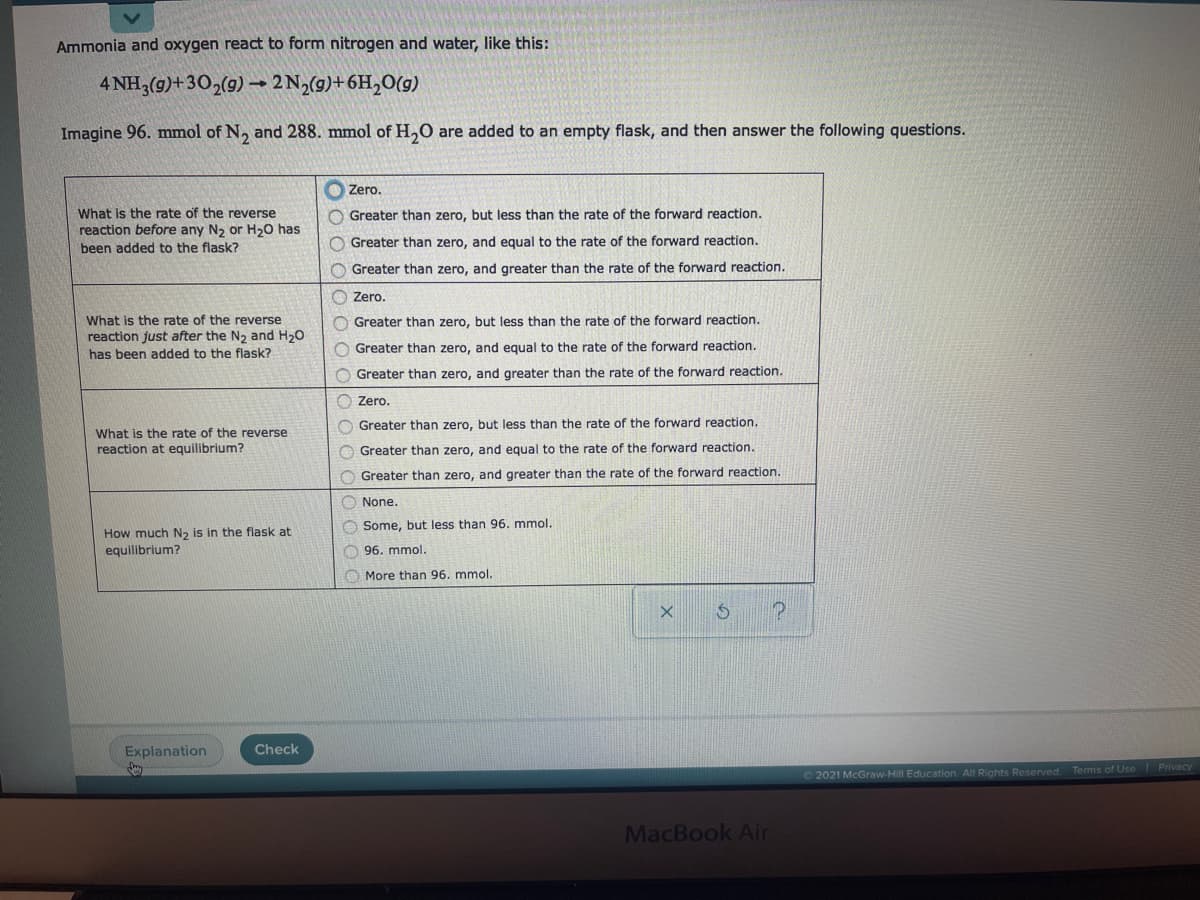Ammonia and oxygen react to form nitrogen and water, like this: 4 NH,(g)+30,(g) - 2 N2(9)+6H,O(g) Imagine 96. mmol of N, and 288. mmol of H,0 are added to an empty flask, and then answer the following questions. O Zero. What is the rate of the reverse reaction before any N2 or H20 has been added to the flask? O Greater than zero, but less than the rate of the forward reaction. O Greater than zero, and equal to the rate of the forward reaction. O Greater than zero, and greater than the rate of the forward reaction. O Zero. What is the rate of the reverse reaction just after the N2 and H20 has been added to the flask? O Greater than zero, but less than the rate of the forward reaction. O Greater than zero, and equal to the rate of the forward reaction. O Greater than zero, and greater than the rate of the forward reaction. Zero. O Greater than zero, but less than the rate of the forward reaction. What is the rate of the reverse reaction at equilibrium? O Greater than zero, and equal to the rate of the forward reaction. O Greater than zero, and greater than the rate of the forward reaction. O None. O Some, but less than 96. mmol. How much N2 is in the flask at equilibrium? O 96. mmol. O More than 96. mmol.
Ammonia and oxygen react to form nitrogen and water, like this: 4 NH,(g)+30,(g) - 2 N2(9)+6H,O(g) Imagine 96. mmol of N, and 288. mmol of H,0 are added to an empty flask, and then answer the following questions. O Zero. What is the rate of the reverse reaction before any N2 or H20 has been added to the flask? O Greater than zero, but less than the rate of the forward reaction. O Greater than zero, and equal to the rate of the forward reaction. O Greater than zero, and greater than the rate of the forward reaction. O Zero. What is the rate of the reverse reaction just after the N2 and H20 has been added to the flask? O Greater than zero, but less than the rate of the forward reaction. O Greater than zero, and equal to the rate of the forward reaction. O Greater than zero, and greater than the rate of the forward reaction. Zero. O Greater than zero, but less than the rate of the forward reaction. What is the rate of the reverse reaction at equilibrium? O Greater than zero, and equal to the rate of the forward reaction. O Greater than zero, and greater than the rate of the forward reaction. O None. O Some, but less than 96. mmol. How much N2 is in the flask at equilibrium? O 96. mmol. O More than 96. mmol.
Chemistry: Principles and Reactions
8th Edition
ISBN:9781305079373
Author:William L. Masterton, Cecile N. Hurley
Publisher:William L. Masterton, Cecile N. Hurley
Chapter11: Rate Of Reaction
Section: Chapter Questions
Problem 4QAP: Consider the following hypothetical reaction: 2AB2(g)A2(g)+2B2(g)A 500.0-mL flask is filled with...
Related questions
Question
Picture

Transcribed Image Text:Ammonia and oxygen react to form nitrogen and water, like this:
4 NH3(g)+30,(g) →
2 N2(9)+6H,O(g)
Imagine 96. mmol of N, and 288. mmol of H,0 are added to an empty flask, and then answer the following questions.
O Zero.
What is the rate of the reverse
reaction before any N2 or H20 has
been added to the flask?
O Greater than zero, but less than the rate of the forward reaction.
O Greater than zero, and equal to the rate of the forward reaction.
O Greater than zero, and greater than the rate of the forward reaction.
O Zero.
What is the rate of the reverse
reaction just after the N2 and H20
has been added to the flask?
O Greater than zero, but less than the rate of the forward reaction.
O Greater than zero, and equal to the rate of the forward reaction.
O Greater than zero, and greater than the rate of the forward reaction.
Zero.
O Greater than zero, but less than the rate of the forward reaction.
What is the rate of the reverse
reaction at equilibrium?
O Greater than zero, and equal to the rate of the forward reaction.
O Greater than zero, and greater than the rate of the forward reaction.
O None.
O Some, but less than 96. mmol.
How much N2 is in the flask at
equilibrium?
O 96. mmol.
O More than 96. mmol.
Explanation
Check
O 2021 McGraw-Hill Education. All Rights Reserved. Terms of Use Privacy
MacBook Air
Expert Solution
This question has been solved!
Explore an expertly crafted, step-by-step solution for a thorough understanding of key concepts.
This is a popular solution!
Trending now
This is a popular solution!
Step by step
Solved in 2 steps with 1 images

Knowledge Booster
Learn more about
Need a deep-dive on the concept behind this application? Look no further. Learn more about this topic, chemistry and related others by exploring similar questions and additional content below.Recommended textbooks for you

Chemistry: Principles and Reactions
Chemistry
ISBN:
9781305079373
Author:
William L. Masterton, Cecile N. Hurley
Publisher:
Cengage Learning

Chemistry for Engineering Students
Chemistry
ISBN:
9781337398909
Author:
Lawrence S. Brown, Tom Holme
Publisher:
Cengage Learning

Chemistry
Chemistry
ISBN:
9781305957404
Author:
Steven S. Zumdahl, Susan A. Zumdahl, Donald J. DeCoste
Publisher:
Cengage Learning

Chemistry: Principles and Reactions
Chemistry
ISBN:
9781305079373
Author:
William L. Masterton, Cecile N. Hurley
Publisher:
Cengage Learning

Chemistry for Engineering Students
Chemistry
ISBN:
9781337398909
Author:
Lawrence S. Brown, Tom Holme
Publisher:
Cengage Learning

Chemistry
Chemistry
ISBN:
9781305957404
Author:
Steven S. Zumdahl, Susan A. Zumdahl, Donald J. DeCoste
Publisher:
Cengage Learning

Chemistry: An Atoms First Approach
Chemistry
ISBN:
9781305079243
Author:
Steven S. Zumdahl, Susan A. Zumdahl
Publisher:
Cengage Learning


Chemistry: The Molecular Science
Chemistry
ISBN:
9781285199047
Author:
John W. Moore, Conrad L. Stanitski
Publisher:
Cengage Learning